How to Test Cell Phone Signal Strength The Right Way
Signal Strength Bars: Not the Best Way to Test Cellular Signal Strength
When you experience dropped calls or sluggish data, what’s the first thing you do? Probably glance at your phone's bars. However, signal bars don't accurately depict how strong the connection really is between your phone and signal source. They’re SUBJECTIVE across all carriers and phones!
You see, there’s no industry standard that ties cell signal strength to the number of bars displayed. It's up to each carrier or phone manufacturer to decide what's 1, 2, 3, 4, or full bars on their service. So, 2 bars on AT&T could be 3 bars on T-Mobile, or 4 bars on Verizon.
Fortunately, there's a better approach.
We fix poor cell phone signal! Find the right signal booster for you:




dBm: The Most Accurate Way to Test Cell Phone Signal Strength
Cell signals are radio waves operating across certain cellular frequencies. Decibel-milliwatts, or dBm for short, measure the strength of the wave once it reaches your mobile device. Signal strength dBm values are expressed as negative numbers.
Cellular signal strength usually ranges from -50 dBm (great signal) to -120 dBm (very poor signal or a dead zone). Being a logarithmic unit, signal strength doubles every three decibels. In other words, a cell signal strength measurement of -97 dBm is twice as powerful as -100 dBm.
Whether testing 4G or 5G signal strength, dBm is consistent across all North American carriers (T-Mobile, Verizon, AT&T, etc.) and devices (Android and iPhone).
Understanding how to find and read dBm is much more accurate and reliable than the bars on your phone.
What’s a Good Signal Strength for a Cell Phone?
If your outside signal ranges from:
| Signal Strength | General Results |
| -50 to -79 dBm | Considered great signal (4 to 5 bars) |
| -80 to -89 dBm | Considered good signal (3 to 4 bars) |
| -90 to -99 dBm | Considered average signal (2 to 3 bars) |
| -100 to -109 dBm | Considered poor signal (1 to 2 bars) |
| -110 to -120 dBm | Considered very poor signal (0 to 1 bar) |
Please note: This chart depicts an educational but general assumption. It may not be true for all carriers as each carrier has its own dBm to bars conversion standard.
The closer you are to 0 dBm, the better your signal strength. dBm moves on a negative scale, so –100 dBm is much weaker signal than –50 dBm.
-90 dBm or over is good and reliable. You’ll be able to enjoy uninterrupted calls and fast data speeds. Around -100 dBm is where most experience inconsistent service and weak reception. Calls drop, texts take longer to send, videos buffer, and webpages are slow. At -120 dBm or lower, your phone is just a paperweight.
Cell phone signal boosters can help increase cell phone signal strength for greater reliability.
How Do I Check My Phone’s Signal Strength?
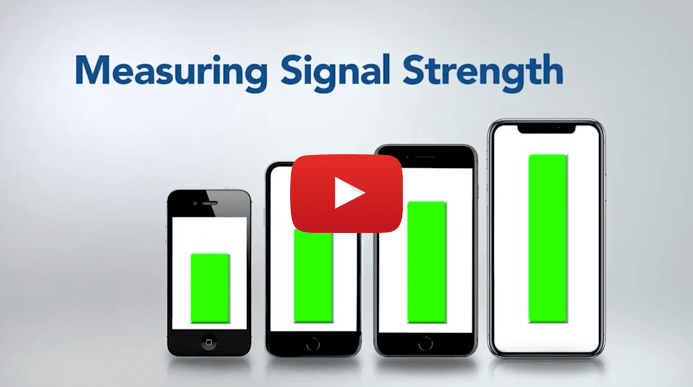
Most smartphones can measure signal strength in dBm through field test mode. The process will vary depending on your device’s make and model.
How to Read Your iPhone Cell Signal?
Starting with iOS 11 and 12, Apple has hidden dBm readings in the iPhone field test mode. However, your iPhone chipset (Intel or Qualcomm) and your carrier (Verizon, AT&T, or T-Mobile) will determine if this method works.
Before getting started, turn off your WiFi connection. Once off, here’s how to access field test mode:
For iOS 17:
- Dial *3001#12345#*
- Look for LTE Rach Attempt and tap.
- Your 4G signal strength is read as rsrp.
- Unfotnetly, 5G dBm values are not available for most users.
For iOS 16:
- Dial *3001#12345#*
- For 4G signal strength, tap LTE field and choose LTE Rach Attempt.
- For 5G signal strength, tap 5G field and choose 5G NR Rach Attempt.
- Your dBm is read as rsrp.
For iOS 15:
- Dial *3001#12345#*
- Your dBm may be visible on the dashboard’s RSRP section. If not…
- Tap the Menu Tab on the top right corner.
- Tap Cell Info.
- Your dBm is read as rsrp.
For iPhone with Intel chipset (iOS 11, iOS 12, iOS 13, and iOS 14)
- Dial *3001#12345#*
- Tap LTE on iOS 11-13, or the Menu Tab on iOS 13-14
- Tap Serving Cell Meas
- Your dBm is read as rsrp0.
iOS 14 pictured
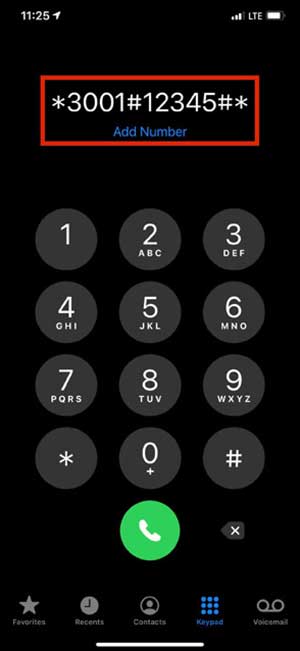
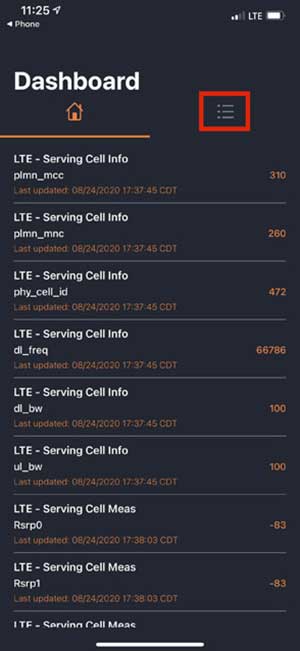
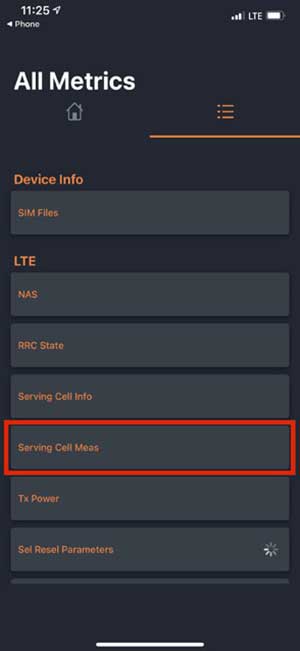
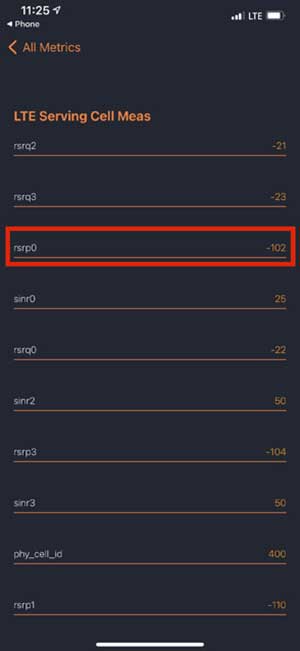
For iPhone with Qualcomm chipset (iOS 11 & 12)
- Dial *3001#12345#*
- Tap 1xEV-DO.
- Your dBm is read as RX AGC0.
For any iPhone pre-iOS 11
- Dial *3001#12345#*
- Swipe down notifications bar.
- Your dBm is in the upper left-hand corner of the screen.
If you’re unable to find any of these options during your field test mode process, you most likely have an incompatible carrier and chipset. The next best method is performing a speed test around areas inside and outside your home. Keep your WiFi off when running a test. Speed results can be used as a better guide than bars to determine what your signal strength looks like and where you get the best signal.
Once we crack the code on dBm readings for iPhones, we’ll update as soon as possible.
How to Read Your Android Cell Signal?
Field test mode on Android varies by phone model and Android OS version. However, it is generally found under the Settings menu.
Typical sequence:
- Tap Settings
- Tap About Phone
- Tap Status or Network
- Tap SIM Status
- Your dBm is under Signal strength
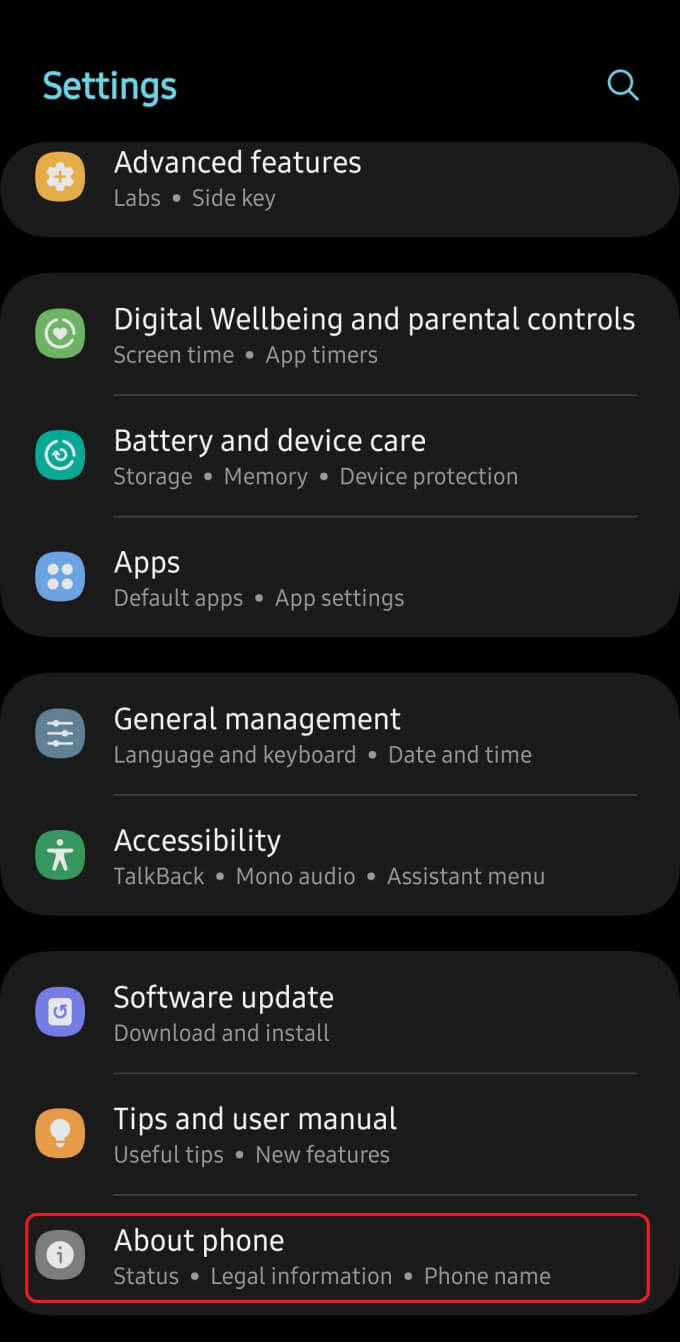
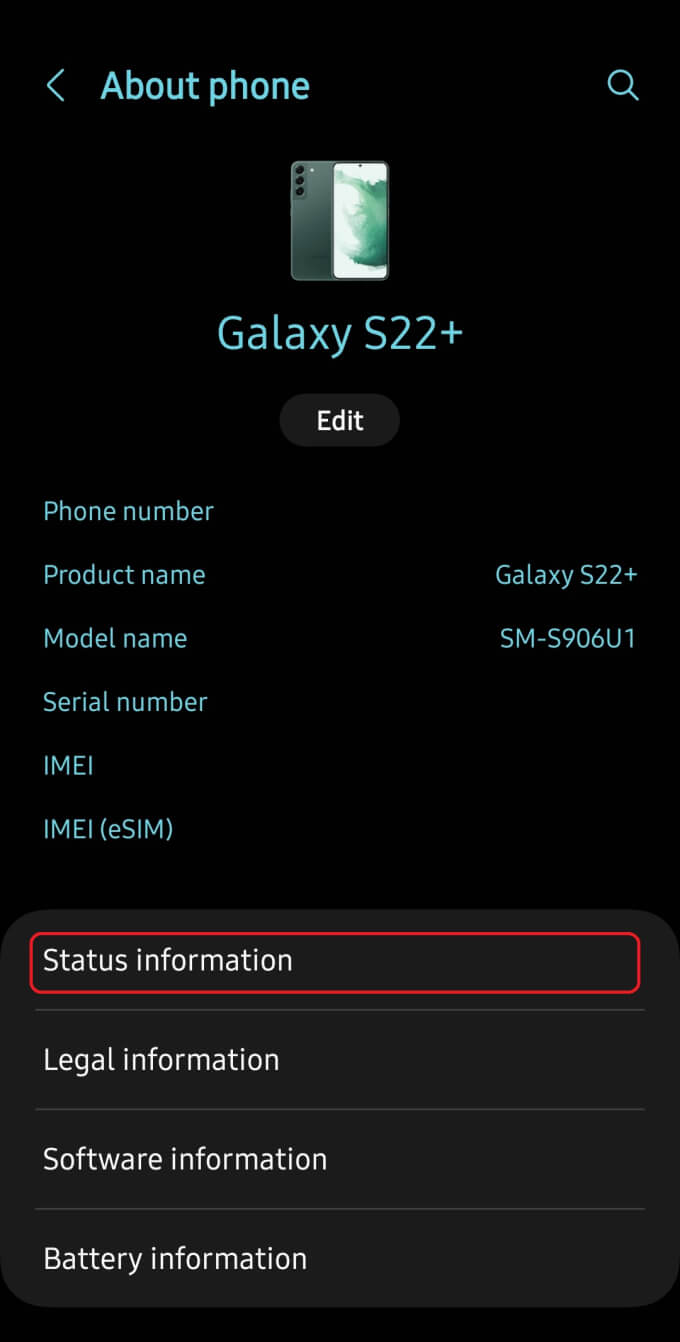
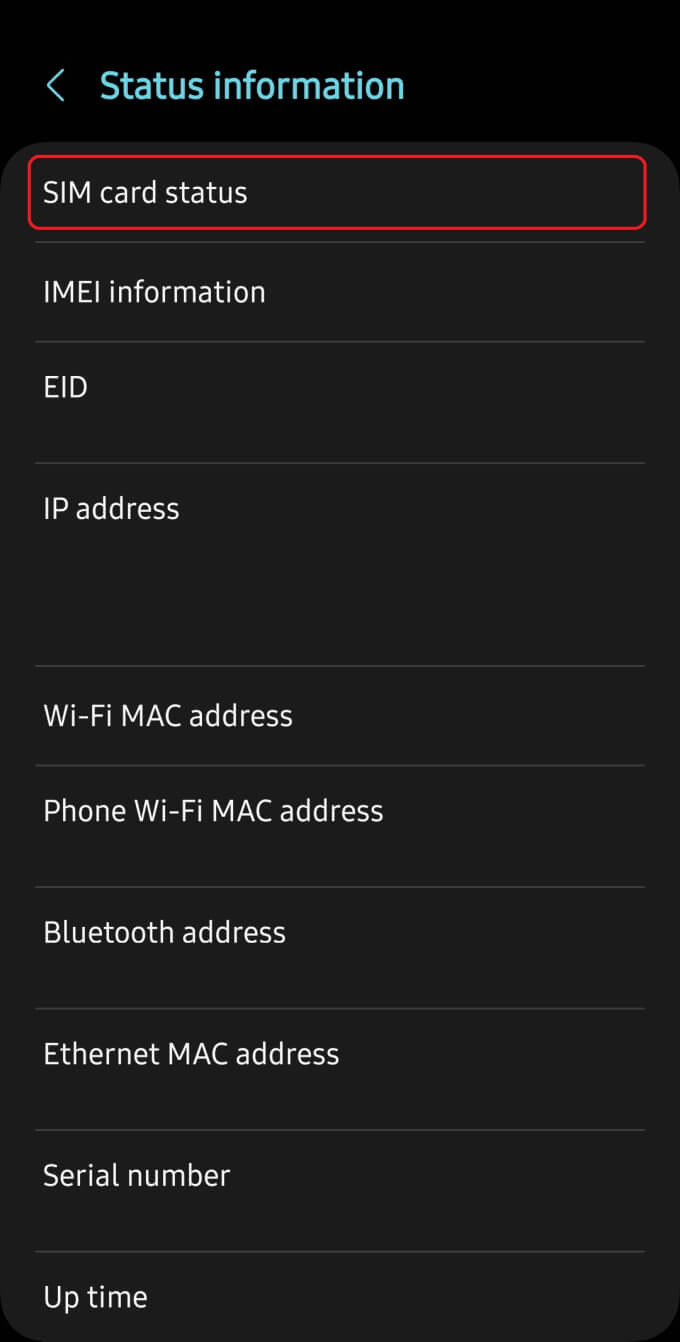
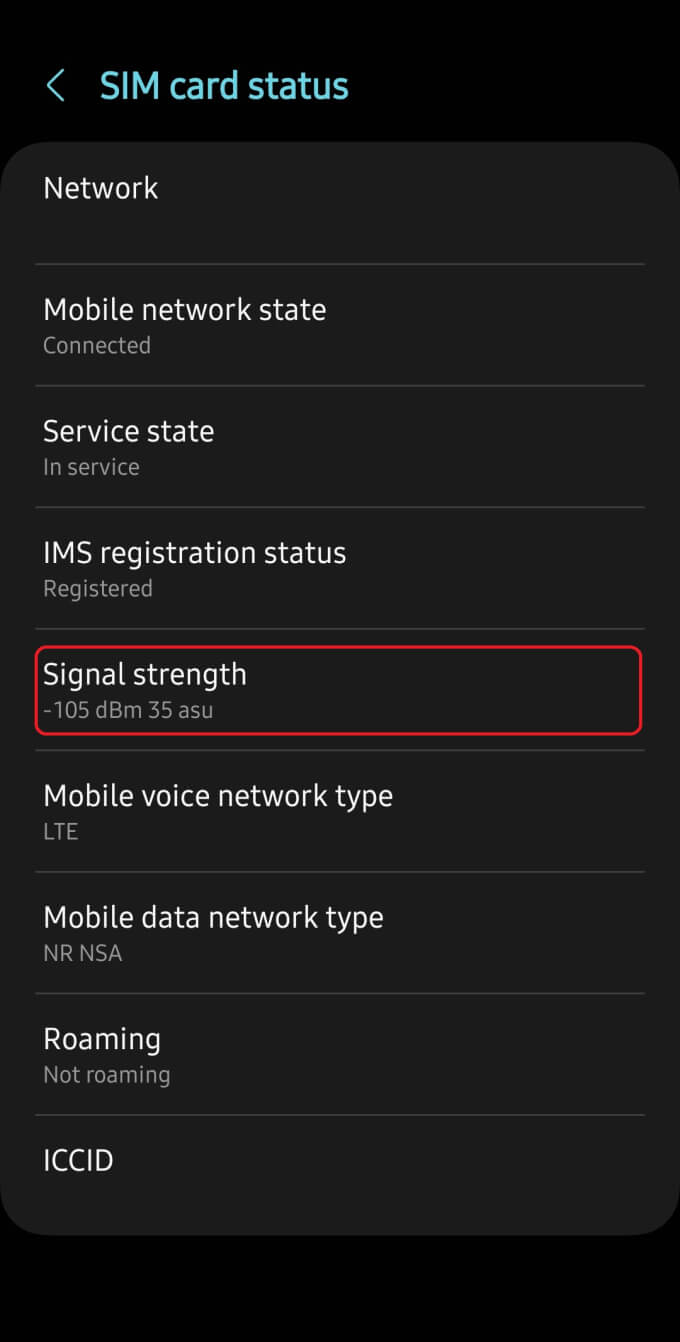
Alternate navigation sequences:
- Tap Settings.
- Tap More Options or More Settings.
- Tap About Phone.
- Tap Mobile Networks.
- Your dBm is under Signal strength.
- Tap Settings.
- Tap System.
- Tap About Phone.
- Tap Status.
- Tap SIM Status.
- Your dBm is under Signal strength.
- Tap Settings.
- Tap About Phone.
- Tap Status.
- Your dBm is under Signal strength.
For Other Types of Devices
For all other devices, you can consult your device's manual or the manufacturer’s website for field test information. If you’re struggling and need help with signal strength testing, call us at 1-800-568-2723 or email us at sales@wilsonamplifiers.com.
Are There Different Ways to Measure Cell Phone Signal Strength?
Field test mode is usually the go-to method since it's easy and doesn't require much data. If field test mode isn't working for you, there are loads of cell phone signal strength apps you can try. Some of our favorites are:
- Network Cell Info Lite (Android): Trusted by many integrators. Features lots of signal measurement tools and provides nearly real-time results. In addition to measuring signal strength (RSRP), it's one of the few apps that also measures cell signal quality (RSRQ). Even if a strong signal is present, poor cell signal quality can cause an unreliable connection.
- weBoost App (Android and iPhone): Designed by weBoost to simplify signal booster installations. Signal strength test tool instantly measures dBm for Androids and provides step-by-step field test instructions for iPhones.
- OpenSignal (Android and iPhone): Highly trusted speed test app. Recommended mostly for iPhone users if unable to test signal strength via field test mode. Allows you to test download, upload, and latency for 4G, LTE, 5G, and WiFi. Also features coverage maps to identify your carrier's coverage in your area.
- SpeedTest by Ookla (Android and iPhone): Most popular speed test analyzer. Recommended mostly for iPhone users if unable to test signal strength via field test mode. Delivers mobile data’s download and upload speeds within seconds.
For more app recommendations, visit Best Apps to Test Signal Strength.
Now That You Know How to Find Your dBm Readings, What's Next?
If you’re only interested in testing your signal strength in a specific location, go to that spot and wait a few seconds for your device to measure your signal.
To measure signal strength throughout your home or property, walk around inside and outside. dBm readings take a few seconds to half a minute to refresh, so walk slowly. As you measure your signal, take notes to find out which areas are closest to 0 dBm.
By doing this, you’ll find your best dBm reading and the area of your home which gets the best signal.
Please note that when standing still you may see a fluctuation of ±5 dBm. This is normal. It’s mainly caused by the number of users connected to the cell tower. The signal power your phone receives decreases when there are multiple devices connected and increases when the number of connected devices decreases.
The same principle applies to speed tests. Whatever area yields the fastest results has the strongest signal. Because of tower traffic, results will vary.
What Causes Poor Signal Strength?
Poor signal strength can be the result of:
- Being too far from your nearest cell tower
- Physical obstructions (trees, buildings, mountains, etc.) interfering with cell signal waves
- Building material blocking cell signals from reaching devices
- Weather distorting cellular signals
- High traffic reducing signal strength
We have a detailed article tackling this topic. For more information, visit Reasons Why Cell Phone Signals Goes Bad.
Why Is My Signal Strength Weak When I Can See the Tower?
Cell towers consist of multiple antennas. These antennas are designed to broadcast cell signals from specific carriers in specific directions at specific power levels. So, while you can see the tower from your home, the tower may not be broadcasting your carrier's signal in your direction. It’s also possible that the signal is not strong enough to reach you or that your carrier isn’t supported by that tower.
How Do I Increase Cell Phone Signal Strength?
There are a few tricks you can try to improve your signal, like using WiFi calling, updating your software, and more. For a full list, visit Easy Ways to Boost Your Cell Signal.
We’ve found cell phone signal boosters to be the best at improving signal strength and providing consistent results. Cellular boosters take your existing outside cell signal, amplify it, and deliver a stronger signal inside. They are 5G ready and significantly improve talk, text, and data for all cellular devices from any carrier.
These are our most popular multi-carrier cellular amplifiers:

Strengthens cell signal strength for small to mid-size homes.
Add To Cart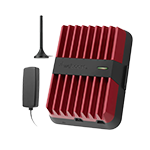
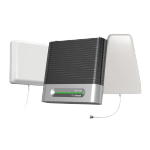
Strengthens cell signal strength for small businesses.
Add To CartWilson Amplifiers is the leading provider of cell phone signal boosters for homes, offices, and vehicles.
Here are some resources that can help you learn more about signal boosters as well as find the best one for you:
- How Does a Signal Booster Work?
- The Complete Best Cell Phone Signal Booster Buying Guide
- Cell Phone Signal Boosters for Rural Areas and Farms
- AT&T Signal Boosters
- Verizon Signal Boosters
- T-Mobile Signal Boosters
- Do Cellular Signal Boosters Really Work with 5G?
If you have any questions, please call us at 1-800-568-2723 or email us at sales@wilsonamplifiers.com. We’re happy to help.
Interested in Learning More? Check Out Our Signal Boosting Info Center


Money Back Guarantee

Technical Support